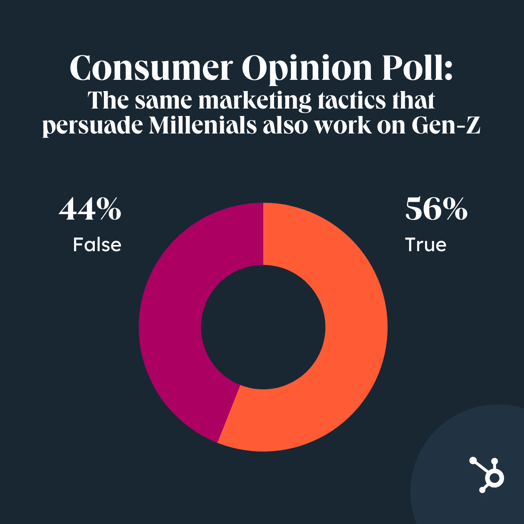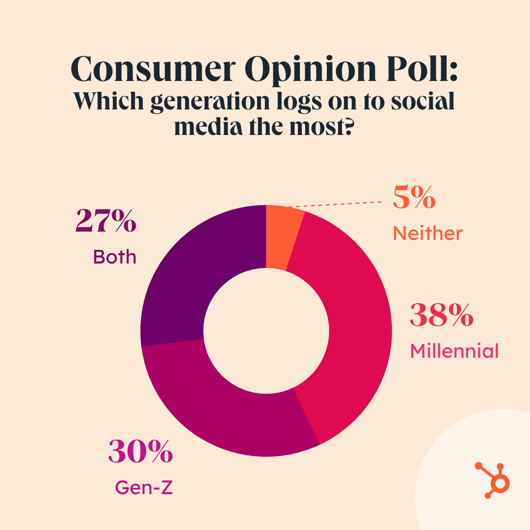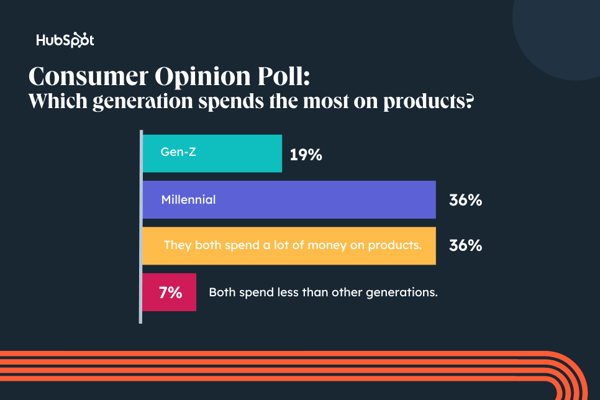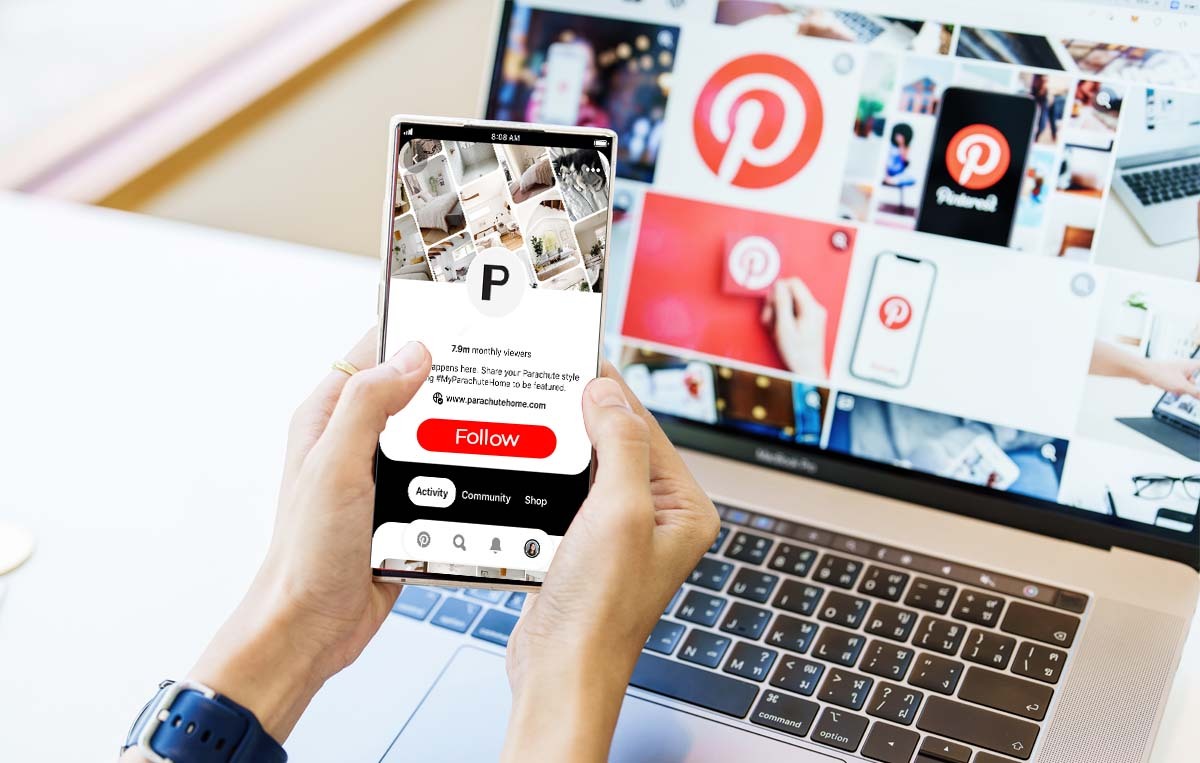
Why Marketers Need to Know the Difference [New Data]
- July 11, 2023
- Knowledge Base
- 0 Comments

In recent years, there’s been a common misconception that Gen Z and millennials are essentially the same.

When companies discuss reaching younger audiences, many often lump Gen Z and millennials into the same group and create one campaign strategy that they believe fits both groups.
Sure, many millennials and Gen Zers are considered “young adults.” Both generations are highly connected to technology and the internet. It might seem effective to run one campaign aimed at both generations, but is this really the right move?
To investigate, I decided to start by letting consumers weigh in on whether or not the same marketing strategies will engage both age groups.
In a Lucid poll, I asked 350 people to tell me if, “The same marketing tactics that persuade millennials also work on Gen Z,” was a true or false statement. And if you think consumers — the people who are being marketed to by brands — would sway one way or another, you’ll be slightly surprised by the results below:

Data Source: Lucid Software
Although 56% of those polled thought the two generations could be marketed to the same way, nearly half disagreed.
As a marketer specializing in audience growth, I sway with the 44% of people who think the same tactics won’t work on both groups — at least not forever.
But is either group of consumers right about their perceptions? In this blog post, I’ll share the cold, hard facts researchers have discovered about generational similarities and differences between millennials and Gen Zers, while occasionally weighing the raw data against the way everyday consumers perceive the two generations. And if you’re in a pinch, jump straight to the info you need:
Millennials vs. Gen Z
According to Pew Research Center, those in the Millennial generation were born between 1981 and 1996, while those in Gen Z were born between 1997 and 2012. In 2023, millennials are between 27 and 42 years old, and Gen-Zers are between 11 and 26.
When you think about the generational differences on the largest possible scale, the oldest millennials are in their early 40s, might be settled down, and could be making larger purchases like cars or homes. The youngest members of Gen Z are 11 years old, might love children’s shows, and won’t be directly making purchasing decisions any time soon.
Aside from the obvious age differences above, here are six more factors that make these two generations fundamentally different.
Factors That Differentiate Millennials and Gen Z
1. They have different attitudes about technology and money.
Understanding the era an age group grows up in can help you identify generational commonalities like motivations, spending or saving habits, or pain points that they all share.
Two things that differentiated each generation’s childhood era included technology and the economy:
Technology
The most obvious difference between the eras each generation was raised in is the presence of technology. Millennials grew up using DVD players, giant personal computers, cell phones with tiny screens, and dial-up internet. At that time, we thought these technologies were groundbreaking.
Now, most children and teens within Gen Z have access to iPads, smartphones, endless Wi-Fi, or streaming services that put our prized DVD players to shame. Many members of this generation might have also grown up in households with early smart home technology.
While millennials watched innovation begin, Gen Z was immersed in it from day one.
But although Gen Z never had to know a time where they didn’t have a cool gadget to solve basic problems, the impact of technology, the internet, and social media has still taken a toll on the group.
Research shows that Gen Z — which has been called the “socially-conscious generation — deals with far more body image, mental health, and cyberbullying issues than any other age group has in the past. Experts have also called Gen Z the loneliest generation despite all of their digital connectivity options.
Economy
Millennials and Gen Z also have different attitudes around money. While they both care about their finances and invest in things that can improve their careers — like higher education.
Both generations are known for improving on financial habits of past generations, however, millennials put their money into buying more products or services that will give them a positive experience, while Gen Z is more focused on savings and practical products.
Millennials in the U.S. built up their own finances shortly after the Recession, which ended in 2009. For many years up until 2019, despite financial woes caused by the poor economy, rising home costs, and high unemployment levels, millennials remained optimistic about their future and finances. However, some studies state that millennials’ financial optimism is dwindling due to post-pandemic inflation, recession, and market slump prevalent in 2023.
Gen Z was born at the beginning of the economic downturn. As the oldest members of Gen Z have entered adulthood, research shows that their past experience of living in the Recession are leading them to make more practical spending decisions.
If you’re marketing to these generations, you’ll want to remember these attitudes about money.
For example, if you want millennials to buy your product, you’ll want to focus on building a brand that offers a pleasant or entertaining customer experience, as well as marketing products or services that give instant gratification. If you’re marketing to Gen Z, you’ll want your campaigns to clearly demonstrate how or why your product will be valuable or practical to them in their daily lives.
2. Gen Z is more likely to make mobile purchases.
By now, you might know that both of these generations are heavily connected to the internet and social media, While millennials watched the internet develop, Gen Z has used it since a very young age.
Each day, millennials spend around 7.5 hours online while Gen Z surfs for nearly 10 hours.
Both millennials and Gen Z also go online primarily with mobile devices, but a big difference between these generations is that Gen Z was practically raised with smartphones. According to YPULSE, 12 is the average age Gen-Z received their first smartphone, five years younger (on average) than millennials.

Source: YPULSE
Gen Z’s mobile-first mindset also impacts how they shop. Members of the generation are twice as likely to make a mobile online purchase than millennials. However, millennials still do shop a lot on mobile devices. In fact, 71% say they do most of their online shopping with a mobile device.
Regarding online content consumption, millennials and Gen Z spend most of their time watching videos and visiting social media sites.
According to a recent study, millennials watch online videos for 1.5 hours per day while Gen Z averages over three hours. Meanwhile, both generations are thought to spend hours daily on social media.
While you might have already known that mobile optimization and video marketing are a key digital strategies, these stats prove that it can help you zone in on young adult generations. If you really want to attract attention from both Gen Z or millennials, you’ll want to create mobile videos, mobile ecommerce sites, or other phone-based experiences that cater to them. You should also be sure to market yourself on platforms that’re already mobile, such as major social media apps.
3. Both spend a lot of time on social media, but the platforms they use are quite different.
To understand how people perceived each generation’s social media usage, I asked the same group of 350 people noted in the Lucid poll above to weigh in on which group they thought spent more time on social media. Here’s what they said:

Data Source: Lucid Software
The poll results above were fairly split between millennials and Gen Z. However, 27% of participants say both generations are “always logged on.”
So, who’s actually the most tuned in to social media? Let’s see what studies on these groups reveal.
The World Economic Forum reports that millennials are logged on to social media for an average of two hours and 38 minutes daily while Gen Z logs on for more than four hours each day.
Aside from the time spent on social media per day, the platforms each generation uses are also slightly different.
While my generation thrived on MySpace and Tumblr and now enjoys platforms like Facebook, Instagram, LinkedIn, and Twitter, Gen Z has zoned in on video-based platforms like Instagram, YouTube, Snapchat, and — more recently — TikTok.
A recent Business Insider survey that polled the oldest half of Gen Z found that participants used Instagram, YouTube, and Snapchat most often.
Although TikTok seemed less popular in the Business Insider survey, this one-year-old platform is one of the fastest-growing social media apps due to booming global Gen Z users.
Gen Z and millennials do have a few social platform preferences in common. One, for example, is Instagram. While Instagram is older and more established than apps like TikTok or Snapchat, it’s also pulled in millennials and video-loving Gen Z members.
YouTube is also a social network that both generations are prominently using. While YouTube was launched when most millennials were children, 96% of Gen Z users have accounts on the video-sharing platform. The video platform is also the second-most used search engine and a platform where many in Gen Z and millennial generations go for product research, as 57% of YouTube’s audience consists solely of the two generations.
4. Millennials pay attention to ads for a longer amount of time.
Each generation’s habits align well with its average attention span when it comes to content consumption.
While millennials will pay attention to content for 12 seconds, Gen Z will only focus on it for eight seconds. Furthermore, Gen Z enjoys quick or short-form video content, like that of Snapchat or Instagram Stories, while millennials value long-form content, such as detailed videos or podcasts.
This means that those advertising or marketing to millennials can get away with slightly longer or more in-depth content while those marketing to Gen Z will want to get their value proposition out as quickly and seamlessly as possible in their campaigns.
As I’ve mentioned above, most of today’s social and online platforms are becoming more video-driven. This mirrors the fact that video usage is growing quickly amongst both generations.
Whether you’re creating long-form content for millennials or short-form clips for Gen Z, you’ll want to embrace mobile-optimized video when promoting your brand to either audience.
Branded Content
When it comes to learning about brands or products on social media, each generation also has its own unique preferences. For example, Gen Z prefers to learn about products through social media-based videos and influencer marketing, while millennials will respond to a variety of promotional strategies including more traditional online ads, social media marketing, and branded podcasts.
Additionally, a recent survey shows that 87% of Gen Z prefers ads or marketing content that shows actual people discussing products. When it comes to millennials, only 37% prefer to see people discussing products in ads or marketing content.
Aside from embracing video and mobile optimization, if you’re marketing to Gen Z, you’ll also want to focus on content that feels more informative and less like an ad. This generation has actively rejected traditional advertising tactics. For example, 84% of Gen Z will skip video ads as quickly as possible, while 65% have downloaded some type of ad-blocker on their mobile devices or computers.
5. Both generations purchase less than past generations.
A common myth about millennials and Gen Z is that both generations are financially illiterate. Because this seems to be a hot topic online and throughout pop culture, I conducted one more Lucid poll, asking the same group noted above to choose which generation they thought spent more money on products.
The Lucid poll below demonstrates this myth and perception as many participants said that they believed both generation spend a lot of money:

Data Source: Lucid Software
Additionally, 36% of survey respondents said millennials spent the most on products, while the same percentage said both generations spend a lot of money. However, less than 20% pointed to Gen Z.
According to various studies, both generations actually spend less than past generations while the oldest Gen Z members are focused on responsible spending.
Most of Gen Z doesn’t even have much buying power yet. But research from multiple sources, including Vice, Insider, and Adobe say that Gen Z aims to spend money pragmatically as compared to other generations. Some analysts suggest that Gen Z’s saving approach is routed in budgeting lessons that the generation learned from the U.S. Recession.
When it comes to the Gen Z members who are old enough to make purchases, research shows that they do less online shopping than millennials. A recent study from Ernst & Young noted that 74% of millennials and only 49% of Gen Z buy products online more than once a month.
But, while Gen Z buys less online, they expect more added service from a brand when they make purchases. The same E&Y study found that 80% of Gen Z valued free delivery. The study also found that 74% of Gen Z values brands that give out discounts or coupons over other businesses.
While millennials are slightly less frugal than Gen Z, the idea that the older generation is more frivolous is also a huge misconception. While many millennials buy their fair share of products, they also earn more annually than most older generations, are the most educated age group, and are notably optimistic about their futures.
6. They have different career motivations.
Both generations have in common that they have placed importance on investing in school or skills training.
While older generations could afford both homes and education, millennials find housing out of financial reach and have mainly focused on paying high costs of tuition.
Despite increasing educational costs, the trend of investing in education isn’t expected to change for either generation. While 10% of Gen Z teens are saving for college, millennial parents are putting more into their children’s college funds than past generations.
Looking at each generation’s work habits can give you a sneak peek into what their finances and daily motivations might be in the future.
While both millennials and Gen Z are driven by higher education and career growth, they still have a few slight differences that you might want to know about, especially if you’re a marketer in academic or B2B fields.
Today, many millennials are working or are enrolled in higher education. For the entire decade between 2020 and 2030, millennials will comprise the largest share of the workforce, representing 40% of the global working-age population by 2030.
But, although most of Gen Z is still in school, they are also very career-minded.
When it comes to looking for jobs, Gen Z adults are more financially motivated than the millennial generation. In fact, 65% of Gen Z employees value salary over other job perks as 74% 2023 US graduates surveyed said they prioritize stability and salary from employers, outweighing factors including a known employer brand, a fast-growing field, or overall benefits. Those in the age group also say they’ll invest in skill training if it means they make more money.
Gen Z also applies for jobs more aggressively than past generations. Only 10% of the generation starts their job search after college while most Gen Z students begin scouting out job options between freshman and sophomore year.
So, what does this mean for your marketing strategy? Both of these generations are hard workers, highly educated, and might earn more than past generations.
However, Gen Z is more driven to make and save money. This means that to persuade Gen Z, you might need to take extra time to brainstorm campaigns that show how your product will help them and why it is worth their money. Odds are, they will be more persuaded by the practicality of a product than the “trendiness” of it.
How to Market to Each Generation
Yes, both generations have a lot of things in common.
And while there are opportunities to market to both generations at once, it might be more beneficial to brainstorm creative campaigns that zone in on one generation or the other. To help you develop a strategy that gains attention from the appropriate audience, here are a few takeaways related to each generation:
Marketing Campaign for Millennials
By now, you might be most familiar with marketing to millennials. Luckily, they’re also a great generation to market to. They’re on the most prominent social media networks today and prefer to consume multiple different styles of multimedia content, from videos to podcasts. They’re also old enough to make purchasing decisions, are more educated than previous generations, and spend considerable time in the research stage before buying a product.
Essentially, many different formats of marketing content will engage millennials because they are regularly looking to be enticed by a new product that will help them in their daily lives.
Because millennials have a slightly longer attention span than Gen Z, you can also get a bit more creative by testing out longer-form content like longer marketing videos or branded podcasts.
The best types of marketing campaigns will inform millennials about how your product can make their lives easier or how it can solve their day-to-day problems. Focusing your strategy on social media or online platforms like Facebook, YouTube or Instagram, where many adults go to research products can also be beneficial to your strategy,
Marketing Campaign for Gen Z
To successfully persuade Gen Z to buy your product, you’ll want to make content that quickly cuts to the chase and explains why your product will provide value to them.
As mentioned above, Gen Z loves to use video to learn about products and spends most of their online time on mobile phones. So be sure to leverage short-form video formatting and mobile-optimized content in your campaigns.
You’ll also want to zone in on the niche social media platforms that they commonly use, such as Instagram, YouTube, TikTok on Snapchat. If you’re not on one of these platforms, but still want to gain brand awareness there, consider sponsoring an influencer who knows the audience and create content that discusses your product.
Marketing Campaign for Gen Z and Millennials
If you absolutely can’t budget pinpointed campaigns for millennials and Gen Z, but know you want to market to young adults, focus on the cusp of both generations by creating a campaign for 18 to 34-year-olds. This will allow you to zone in on young and slightly older adults that can actually make purchasing decisions.
While a campaign with this age target might be slightly more favorable to millennials between 27 and 42, there’s still a chance you could grab attention from older teenagers who will soon be able to make more purchases if they can’t already.
Despite the differences between these two generations, there are also two big similarities: both love social media and instant gratification. Be sure that your campaign clearly explains why your product will be valuable to the age group you’re pitching it too, and leverage the social media networks that the age group you’re targeting has in common.
For example, if you’re focused on promoting your product to people in the 18 to 34 range, you’ll want to be on Instagram, YouTube, and Facebook, because most members of this age group are using all three of them on a regular basis.
If you can create a campaign that leverages key social networks accordingly while highlighting why your product is so instantly gratifying and useful, you might attract interest from both groups fairly quickly.
Tips for Knowing Your Audience
As you create campaigns around a specific audience or age group, it’s important to do digging to learn what motivates this group of people, what their purchasing habits are, where they spend the most time, and what they’re looking for in a product. Here are a few tips that can help you in this research:
- Identify specific demographics: Try not to be too specific or too broad. Pick an audience you can learn a lot about quickly that well aligns with your product and start researching that demographic.
- Learn about their work and education backgrounds: This will give you insight on what motivates them and how much they’re able to spend on a product.
- Find out which social platforms they use: Once you do this, you can research each platform and leverage it appropriately during your campaign.
- Consider writing a buyer persona: A buyer persona is a fictional character that has a very similar lifestyle to your ideal buyer. Having a persona in mind can help you quickly think about campaigns and strategies that they’ll engage most with. It’s also a handy place to organize all of your detailed research findings into one simple place.
Want to learn more about Gen Z or millennials specifically? Check out this blog post on marketing to Gen Z or this piece on millennial marketing.
Editor’s note: This article was originally published in December 2019 and has since been updated for comprehensiveness.
![Download Now: The State of U.S. Consumer Trends [Free Report]](https://no-cache.hubspot.com/cta/default/53/ebf9ec8e-a468-455a-943e-80aa4e6be694.png)




